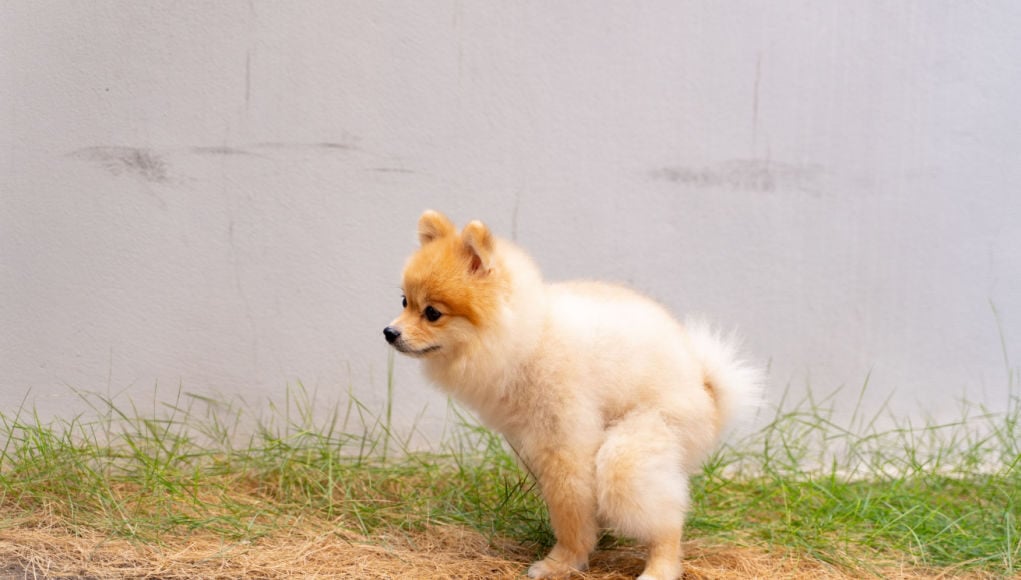Table of Contents
Seeing green dog poop can be pretty alarming. Occasionally, you may notice your pet passing poop in different colors.
You may not realize that specific dog poop colors have different meanings, giving you a clue about your pet's health.
If you see that your dog poop is green, never ignore it and know what it could mean in this blog.
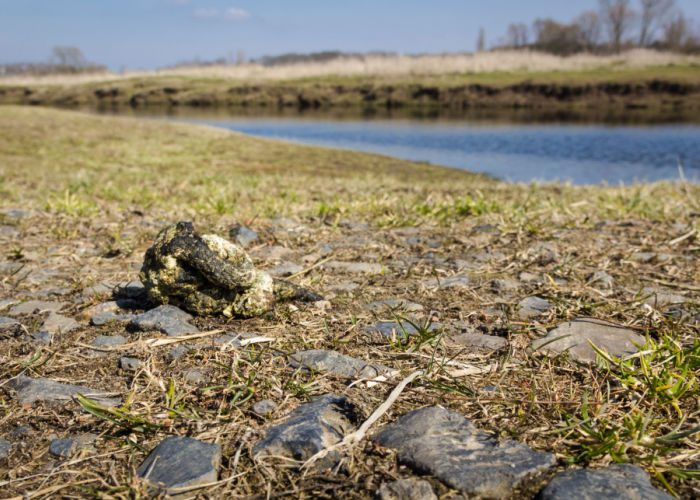
Green Dog Poop Meaning
When your dog has green poop, it often leaves you wondering, “Why is my dog's poop green?”
Being mindful of your pet's poop can give you an insight into what is happening inside their bodies—how they are feeling and what they have eaten. Pay attention, particularly to any changes in the color and consistency of their stool.
Although Fido does not usually pass green poop, it can occur occasionally. The poop color indicates how well his digestive system ingests and absorbs the food.
There are plenty of other reasons behind this occurrence. While some are not a significant concern, others will require an immediate vet visit.
Related: Dog Poop Color Chart: What It All Means
Why is My Dog's Poop Green
Occasionally, the characteristic of your dog's poop may look odd enough to catch your attention.
When your dog poop is green, the color might not be the only thing off. The consistency of the stool may range from runny to greasy and mucousy.
Sometimes, you will notice bloody streaks or brownish chunks with a strong odor.
In addition to the color and consistency, take note of your pet's attitude, changes in appetite, and energy level. Other signs to watch for are vomiting, fever, and weight loss.
Monitoring other symptoms is crucial as it will help the veterinarian identify the underlying causes of the change in stool color.
Knowing what may have caused the change of color can help you understand and deal with the problem better.
Parasite Infestation
The presence of parasites in your dog's intestinal tract may have caused green-colored poop with slimy consistency. Also, watch out for any signs of constipation or straining.
Take note of the signs and the characteristics of your excrement so you can share them with the vet.
For instance, Giardia is a typical dog parasite that causes your dog's poop to become soft and unusual.
Be careful when cleaning dog poop infested with Giardia because the parasite can be easily transmitted between dogs and humans.
Related: 4 Common Types of Worms in Dog Poop

Something Your Dog Ate
The most common reason your dog has green poop is that he may have overeaten something green.
For instance, when your dog eats a lot of grass or plant material, a large amount of chlorophyll can contribute to the color of the stool.
While munching grass is normal and not harmful to your pup, it can indicate a lack of nutrition in their diet. You can quickly resolve this problem by adding more fiber to their diet to get their poop back to normal.
Other causes include overeating green stuff, such as Crayolas. While Crayolas are non-toxic, they can cause stomach upset when consumed in large quantities.
Intestinal Problems
Intestinal tract problems, like colitis or gallbladder disease, can cause your dog's poop to turn green in color.
When your dog's digestive tract fails to absorb the bile, its green tint will be passed along with poop. Other signs of gastrointestinal problems include slimy, runny stools.
If you suspect your dog has intestinal problems, contact the vet ASAP!
Other gastrointestinal disorders that cause your dog's poop to become green include:
- Inflammatory bowel disease
- Idiopathic hemorrhagic gastroenteritis
- Food allergies
- Small interesting bacterial overgrowth
- Viral infections
- Colitis
- Hepatitis
- Cholangitis
Rat Bait Poisoning
Ingestion of toxins, such as rodenticide, is another reason why your dog's poop has turned green. Rodenticide has a green-tinted pigment, which is highly toxic when consumed.
Your dog may not initially show any adverse reactions, but this is an emergency. Rodenticide, when ingested, can cause your dog's blood to lose its clotting ability. It makes even the smallest of cuts and bruises life-threatening to your dog.
If you believe your pet might have ingested rodenticide, it is vital to get them to a vet immediately.
Take the box of rodenticide so the vet can get the proper treatment for your dog. Fortunately, the treatment can be as simple as Vitamin K.
Fatty Diet
A diet high in fat affects the appearance of your dog's stool and overall health. It can result in greasy, greenish-brown poop.
A fatty diet can put your pet at risk of pancreatitis, lethargy, vomiting, diarrhea, abdominal pain, and even death if left unchecked.
Changes in Diet
Sudden diet change can also be a factor that contributes to the change in poop color.
In most cases, it takes time for your pet's digestive system to adapt to specific dog food. Sudden changes can disturb their usual digestive balance, causing the poop to become green and runny.
Expect about 7 to 10 days to slowly change your old dog food to a new one by adding an increasing amount of new dog food to the old.
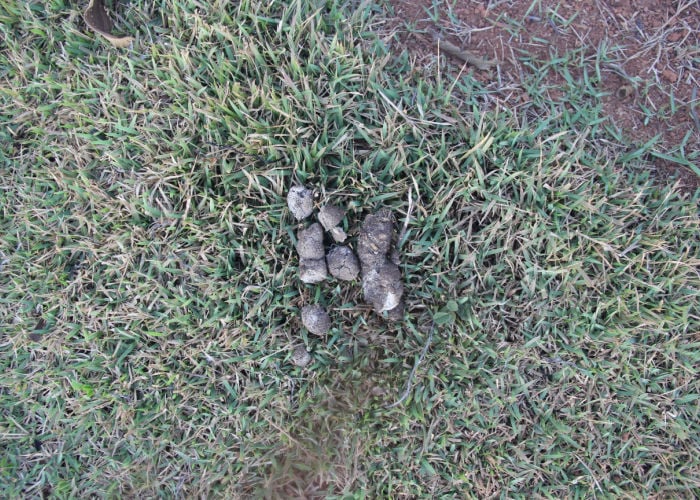
Characteristics of Green Stools in Dogs
Sometimes, the colors may not be enough to determine that there's something wrong with your dog's health. It's best to look at their texture and other characteristics.
Watch out for these other aspects if you notice your dog pooping on green-colored stools.
Hard, pebble-like, or crumbly
Dehydration and constipation can cause overly hard stools. Make sure your pet drinks enough water. Also, add more moisture and fiber to their diet.
Runny and watery
Runny and watery poop usually indicates your dog has diarrhea, which sudden diet changes, impending illness, or environmental stress may trigger.
Slimy, covered in mucus
If you notice a mucus-like substance coating the stool, your dog may suffer from mild colon inflammation, gastrointestinal infection, or parasitic infestation.
Bloody
Several causes contribute to blood-speckled excrement. Constipation may cause abrasions and minor cuts within the anus when your dog. Also, parasite infestation can trigger bloody dog poop.
Different shades of color
Whether your dog passes bright green or dark green poop, it tells much about your pet's digestive condition.
Make sure to determine that the change in color is due to ingesting green-colored foods and not an underlying health condition.
When is Green Dog Poop a Concern
Often, green-colored poop in dogs is not a cause for concern. However, it is something that you should not ignore.
It could indicate a problem in your dog's health, and here's when it becomes a problem:
- Although green dog poop is often a result of GI tract disturbance and rapid movement of the food through the large intestine. When the food moves too fast, the bile does not have enough time to break down and get absorbed.
- Other factors that require immediate vet care and treatment include liver shunts, Addison's Disease, and exocrine pancreatic insufficiency.
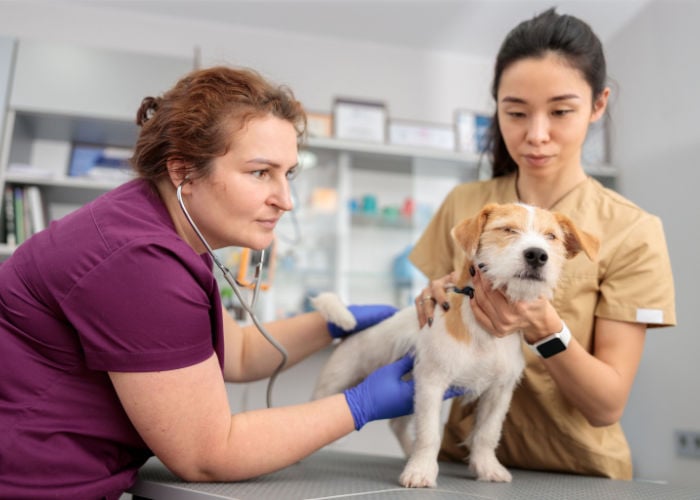
What To Do if Dog Poop is Green
Green-colored poop is not an emergency, especially if you know why. If you notice your pet consuming grass or eating the frosting off your Saint Patrick's Day cupcakes, expect your dog to pass green stools.
The moment you start seeing green dog poop, you can do the following steps:
- If you see your dog frequently out grazing, try adding high-fiber foods into his diet to help them get the digestive regulation they are looking for.
- If you have recently switched your dog's diet and noticed that their poop turned green, feed them back with their old food and try a more gradual transition to prevent stomach upset.
- Slowly transitioning their diet helps clear this problem, especially if your pet shows no other signs.
- Make sure to have your dog checked for potential intestinal parasites and get treatment as soon as possible.
However, if your pet passes green poop several times or shows other distressing signs, act quickly and take them to the nearest veterinary clinic for a checkup and treatment.
- For mild digestive problems accompanied by occasional vomiting, try not feeding your dog for 4 to 6 hours and only providing him with a small amount of water.
When you feed your dog a bland diet of boiled chicken and rice for several days, it may help alleviate stomach upset.
However, moderate to severe GI infections like parvo require diet changes, fluids, antibiotics, and anti-nausea medications. Treatment can cost between $200 to $2000, depending on the severity of the condition.
- When your pet has green diarrhea that occurred more than once or is accompanied by frequent vomiting, abdominal pain, or fever, take your dog to the vet for prompt treatment.
It can also indicate a severe parasitic issue or gastrointestinal infection. Diagnostics and treatment may include fecal examination, blood work, imaging, antibiotics, anti-nausea medication, and hospitation.
Treatment costs may vary depending on your dog's condition, ranging between $200 to $2000 or even more.
- If you think Fido ingested rat poison, take him to the vet right away for an antidote or treatment. Rodenticide ingestion treatment can cost you about $200 if detected early.
However, the treatment cost can go as high as $2000 or more if your pet starts to show signs and requires blood transfusions and hospitalization. The earlier you get treatment, the better the outcome.
Related: 11 Dog Stomach Problems (Gastrointestinal and Digestive): Causes and Treatment
Frequently Asked Questions About Greed Dog Poop
When to See a Vet for Green Dog Poop
If your dog has green poop with unusual consistency, frequency, and odor, monitor them closely for a few days as long as your pet does not show any other signs, such as lethargy, vomiting, loss of appetite, or weight loss.
If the issue does not clear up after 48 hours, take your dog to a local vet clinic.
What Does Giardia Poop Look Like in Dogs?
The most common symptom that your dog has an active giardia infection is greenish, loose, and slimy stool.
While in some cases, diarrhea may also be yellowish or brownish in color, it will always be watery. Your dog's poop can also be tainted with blood due to giardia infection.
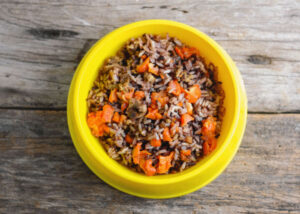
Can Chicken and Rice Make Your Dog Poop Green?
Feeding your dog chicken and rice may cause him to pass green-colored excrement.
Common food allergies may trigger this problem, but the symptoms usually disappear within 2 to 3 days.
If the symptoms do not clear after a couple of days, consult a vet right away.
If your dog has a sensitive stomach, make sure to reduce the number of chicken and rice meals. Wait for several days until your dog's stomach has fully recovered before transitioning your dog's foods to a standard diet.
Green Dog Poop: Summary
The thought of checking your dog's poop may sound gross, but as pet owners, it is an excellent way to analyze your pet's overall health. Also, it helps you understand and deal with green dog poop issues.
Here is a quick summary of what to do in case your dog poops green excrement:
- Identify what is causing your dog to pass green stools. It could be eating too much grass, sudden diet changes, ingesting rat poison, giardia infestation, fatty diet, or viral infection, such as parvo.
- A healthy poop is brown in color, shaped like a log, and has consistent texture and odor,
- If you notice that your dog is eating too much grass, it could indicate that your pet craves the nutritional fiber in the grass. Make sure to add more fiber to this diet.
- If your dog's poop is consistently green, visit your trusted vet for a more thorough health checkup.
Poop is more than a solid bodily waste of undigested food and bacteria. Its color, texture, consistency, amount, and content can provide insight into your dog's health and potential problems.
Do you have any more ideas to share about green dog poop? Perhaps, some tips on how you helped your dog manage the problem?
Feel free to share them with us in the comment section below!


